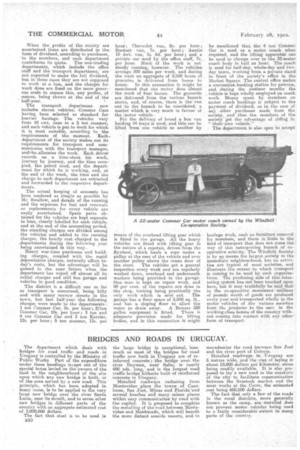BRIDGES AND ROADS IN URUGUAY,
Page 14

If you've noticed an error in this article please click here to report it so we can fix it.
. The department which deals with bridges for road traffic and roads in Uruguay is controlled by the Ministry of Public Works. Part of the expenditure under these headings is met out of the special taxes levied on the ownersof the land in the neighbourhood of the site upon which any new bridge is built, or of the area served by a new road. This principle, which has been adopted in many cases, is to he applied to the very large new bridge over the river Santa Lucia, near its mouth, and to seven other new bridges in different parts of the country with an aggregate estimated cost of 3,000,000 dollars.
The fact that tel is to be used ic B10 the large bridge is exceptional, inasmuch as mast of the bridges for roadtraffic now built in Uruguay are of reinfereed concrete; -the bridge over the river Dayman, near Salto, is nearly 400 yds. long, and is the longest road traffic bridge hitherto built of reinforced concrete in Uruguay.
Metalled roadways radiating from Montevideo place the towns of Cane. lones, San Jose', Minas and Flarida-and several beaches and many minor places within easy communication by road with the capital. It is proposed to complete the metalling of the road between Montevideo and l‘• donado, which will benefit the snore distant seaside resorts, and to
macadamize the road between San Jose and the river port of Colonies Metalled roadways in Uruguay are 5 metres wide, and the cost of aying is about 10,000 dollars per kilometre, stone being readily available. It is also proposed to lay a new road in the outskirts of the city to facilitate communication between the livestock market and the meat works at the Cerro, the estimated cost being 600,000 dollars.
The fact that only a few of the roads in the rural districts, more generally known ELS the camp, are metalled does net prevent motor vehicles being used to a fairly considerable extent in many parts of the country.






























